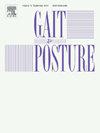Age-stratified validation of the performance index (P-Index) as a metric for dual-task cost in functional mobility across the adult lifespan
IF 2.2
3区 医学
Q3 NEUROSCIENCES
引用次数: 0
Abstract
Objectives
To evaluate the predictive validity of the Performance Index (P-Index), a metric that integrates functional mobility and accuracy of cognitive responses to quantify dual-task (DT) performance, for cognitive outcomes measured by the Mini-Mental State Examination (MMSE) across the adult lifespan during the instrumented Timed Up and Go (iTUG) test.
Study design
This cross-sectional study included 247 participants from diverse age groups who completed single-task (ST) and dual-task (DT) iTUG tests in a semi-randomized order. The P-Index (range: 0–1) was calculated using iTUG completion times (measured with inertial sensors) and cognitive task accuracy (backward recitation of days of the week), with weighted components for time (W1) and accuracy (W2).
Main outcome measures
The relationship between the P-Index and MMSE scores.
Results
The optimal weighting for predictive accuracy was W1 = 0.6 and W2 = 0.4, yielding a P-Index threshold of 0.90 with a sensitivity of 0.69 and specificity of 0.64 for detecting MMSE scores ≥ 26. Participants who reported depressive symptoms (OR: 1.19, p = 0.02) were less likely to achieve MMSE ≥ 26. Conversely, each additional medication (OR: 1.04, p = 0005) and each unit increase in the P-Index significantly improved the odds of higher MMSE scores (OR: 3.89, p = 0.002).
Significance
The P-Index reliably measures dual-task interference and serves as a strong predictor of cognitive performance across the adult lifespan. It shows potential as a practical tool for cognitive-motor assessments and early detection of cognitive decline.
绩效指数(P-Index)作为成人生命周期中功能移动的双重任务成本度量的年龄分层验证
目的评估绩效指数(P-Index)的预测有效性,该指标整合了功能流动性和认知反应的准确性,以量化双任务(DT)的表现,在仪器计时的iTUG测试中,通过迷你精神状态检查(MMSE)测量了整个成人寿命期间的认知结果。本横断面研究包括247名来自不同年龄组的参与者,他们以半随机顺序完成单任务(ST)和双任务(DT) iTUG测试。p指数(范围:0-1)使用iTUG完成时间(用惯性传感器测量)和认知任务精度(向后背诵一周中的日子)计算,时间(W1)和精度(W2)加权。主要结果测量:p指数与MMSE评分之间的关系。结果MMSE评分≥ 26时,预测准确率的最佳权重分别为W1 = 0.6和W2 = 0.4,p指数阈值为0.90,灵敏度为0.69,特异性为0.64。报告抑郁症状的参与者(OR: 1.19, p = 0.02)达到MMSE≥ 26的可能性较小。相反,每增加一次用药(OR: 1.04, p = 0005)和p - index每增加一个单位均显著提高MMSE得分的几率(OR: 3.89, p = 0.002)。p -指数可靠地衡量双任务干扰,并作为一个强有力的预测在整个成人寿命的认知表现。它显示了作为认知运动评估和认知衰退早期检测的实用工具的潜力。
本文章由计算机程序翻译,如有差异,请以英文原文为准。
求助全文
约1分钟内获得全文
求助全文
来源期刊

Gait & posture
医学-神经科学
CiteScore
4.70
自引率
12.50%
发文量
616
审稿时长
6 months
期刊介绍:
Gait & Posture is a vehicle for the publication of up-to-date basic and clinical research on all aspects of locomotion and balance.
The topics covered include: Techniques for the measurement of gait and posture, and the standardization of results presentation; Studies of normal and pathological gait; Treatment of gait and postural abnormalities; Biomechanical and theoretical approaches to gait and posture; Mathematical models of joint and muscle mechanics; Neurological and musculoskeletal function in gait and posture; The evolution of upright posture and bipedal locomotion; Adaptations of carrying loads, walking on uneven surfaces, climbing stairs etc; spinal biomechanics only if they are directly related to gait and/or posture and are of general interest to our readers; The effect of aging and development on gait and posture; Psychological and cultural aspects of gait; Patient education.
 求助内容:
求助内容: 应助结果提醒方式:
应助结果提醒方式:


